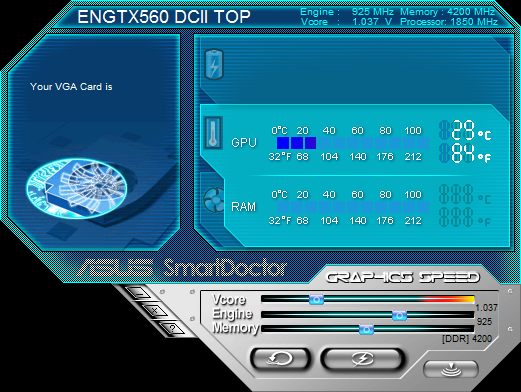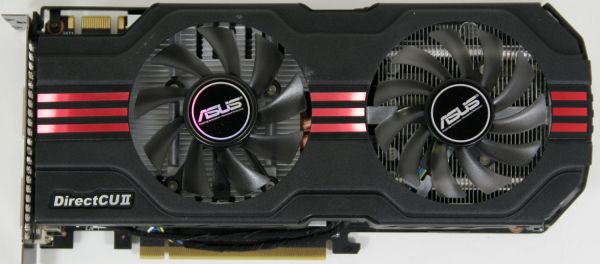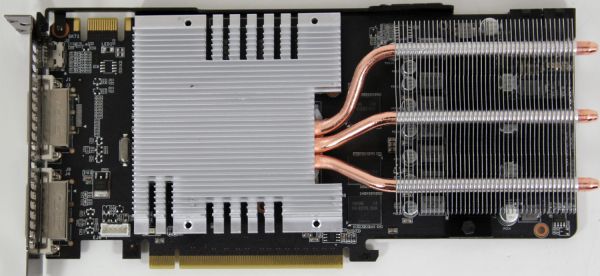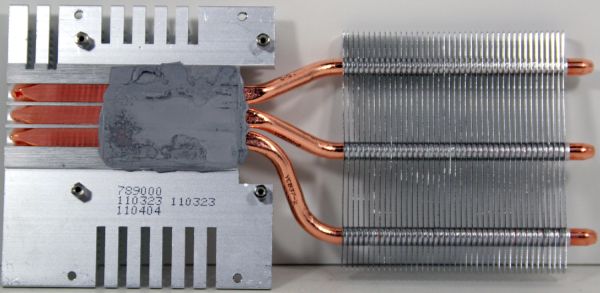NVIDIA's GeForce GTX 560: The Top To Bottom Factory Overclock
by Ryan Smith on May 17, 2011 9:00 AM ESTMeet ASUS’s GTX 560 DirectCU II Top
As we mentioned previously, the card we’re sampling today is ASUS’s GTX 560 DirectCU II Top, the faster of ASUS’s two GTX 560s, and the 2nd fastest card on NVIDIA’s launch list. It’s clocked at 925MHz for the core and 4200MHz (data rate) for the memory, giving it a sizable 115MHz (14%) core clock and 196MHz (5%) memory clock advantage over the GTX 560’s reference clocks. As we’ll see when we get to benchmarking, this is fast enough to start challenging reference clocked GTX 560 Tis.
We’ve reviewed a number of ASUS DirectCU cards in the past, but this is the first card we’ve reviewed from them that uses the DirectCU II cooler. What’s the difference? The DirectCU (I) was an open air cooler with single fan mounted at the center of the card; the DirectCU II uses two 80mm fans. In practice it’s similar to some previous coolers we’ve seen such as MSI’s Twin Frozr, however ASUS has managed to throw in their own unique adjustments.
Notably, the DirectCU II uses a different fan configuration than what we normally see with these dual-fan cards. Normally these cards are symmetrical – the left and right fans are the same. In the case of the DirectCU II ASUS is using different fans, with the left side using a taller 9 blade fan while the right side uses a more typical shorter 11 blade fan. ASUS hasn’t specifically mentioned why they do this – we’d assume they found it more efficient – but it’s an interesting deviation from what we normally see with this style of a cooler.
Removing the shroud and fans, we’re down to the actual HSF the cooler uses. ASUS has ditched the two large aluminum heatpipes running across the top of the card for a trio of smaller copper heatpipes running directly from the base of the HSF to the secondary heatsink over the rear of the card. These dual aluminum heatsink configurations are typical for dual-fan cards. Flipping the HSF over and we can see the base of the unit; ASUS has the heatpipes make direct contact with the GPU rather than using a baseplate to spread the heat out some. Both the heatpipes and the primary heatsink end up making contact with the GPU as a result.
Cooling for the VRMs is provided by small spring-loaded heatsinks attached directly to the MOSFETs. The airflow from the fans provides cooling for these heatsinks, along with some airflow over the GDDR5 memory modules to keep the card’s RAM cool.
Overall the build quality of the GTX 560 DirectCU II is up to the same solid standards we see out of an ASUS DirectCU card. ASUS continues to be the only manufacturer we see regularly using stiffening brackets with an open air cooler, making the card extremely rigid and almost impossible to flex. Even the shroud is surprisingly durable, having apparently been coated in some kind of metal or metal-like rigid plastic.
Moving on, with the factory overclock power consumption is undoubtedly higher than NVIDIA’s reference value of 150W. ASUS and other video card manufacturers don’t normally provide a TDP for the card, but we’d guess it’s around 170W, similar to that of the reference GTX 560 Ti. Providing this power is a pair of PCIe power sockets, which ASUS has helpfully oriented at the top of the card rather than the rear as we’ve seen on most other GTX 560/460 cards.
As is normally the case with ASUS DirectCU cards, the tradeoff in their design is that their cards are a bit bigger on average. Like the DirectCU (I), ASUS’ shroud is longer than the PCB itself, so while the PCB is only around 9.15” the total length of the card is just over 9.8”, versus 9” for the reference GTX 560 Ti. Meanwhile for display outputs, ASUS is following the typical NVIDIA design: 2x DVI ports and a single mini-HDMI port.
Rounding out the package, ASUS includes their usual collection of utilities: GamerOSD and SmartDoctor. SmartDoctor hasn’t changed since the last time we’ve looked at it; it still provides a passible but ultimately dated GUI for monitoring and overclocking the card. ASUS is offering voltage tweaking on this card for overclockers looking to push the card higher than 925MHz, so overvolting through SmartDoctor is a necessity for getting much farther than 925MHz. A good GF114 GPU should be able to hit near 1GHz with some extra voltage, though in our case we were only able to push our card to 950MHz, even at 1.075v.

The rest of the collection is your usual pack-in fare: a multi-language quick setup guide, a mini-HDMI to HDMI dongle, 2 molex-to-PCIe power adapters, and a DVI-to-VGA dongle.
Finally, as the GTX 560 DirectCU II Top is ASUS’s top-tier GTX 560, it also has a top-tier price: ASUS is charging an additional $20 over the GTX 560 OC, for an MSRP of $219.














66 Comments
View All Comments
L. - Thursday, May 19, 2011 - link
You'll have some trouble doing an apples to apples comparison between a 580 and a 6970 ...The 580 tdp goes through the roof when you OC it, not so much with the 6970.
The 580 is a stronger gpu than the 6970 by a fair margin (2% @ 2560 to 10+%@1920), does not depend much on drivers.
The 580 costs enough to make you consider a 6950 crossfire as a better alternative . or even 6970 cf ...
The day drivers will be comparable is about a few months from now still as both cards are relatively fresh.
mosox - Tuesday, May 17, 2011 - link
And of course the only factory OCed card in there is from Nvidia.Can you show me ONE review in which you did the same for AMD? Including a factory OCed card in a general review and compare it to stock Nvidia cards?
Are you trying to inform your readers or to pander to Nvidia by following to the letter their "review guides"? No transparency in the game selection (again that TWIMTBP-heavy list), OCed cards, what's next? Changing the site's color from blue to green? Letting the people at Nvidia to do your reviews and you just post them in here?
:(
TheJian - Wednesday, May 18, 2011 - link
The heavily overclocked card is from ASUS. :)NV didn't send them a card. There is no ref design for this card (reference clocks, but not a card). They tested at 3 speeds, giving us a pretty good idea of multiple variants you'd see in the stores. What more do you want?
Nvidia didn't have anything to do with the article. They put NV's name on the SLOWER speeds in the charts, but NV didn't send them a card. Get it? They down-clocked the card ASUS sent to show what NV would assume they'd be clocked at on the shelves. AT smartly took what they had to work with (a single 560 from ASUS - mentioned as why they have no SLI benchmarks in with 560), clocked it at the speeds you'd buy (based on checking specs online) and gave us the best idea they could of what we'd expect on a shelf or from oem.
Or am I just missing something in this article?
Is it Anandtech's problem NV has spent money on devs trying to get them to pay attention to their tech? AMD could do this stuff too if they weren't losing 6Bil in 3 years time (more?). I'm sure they do it some, but obviously a PROFITABLE company (for many more years than AMD - AMD hasn't made a dime since existence as a whole), with cash in the bank and no debt, can blow money on game devs and give them some engineers to help with drivers etc.
http://moneycentral.msn.com/investor/invsub/result...
That link should work..(does in FFox). If you look at a 10 year summary, AMD has lost about 6bil over 10yrs. That's NOT good. It's not easy coming up with a top games list that doesn't include TWIMTBP games.
I tend to agree with the link below. We'd have far more console ports if PC companies (Intel,AMD,Nvidia) didn't hand some money over to devs in some way shape or form. For example, engineers working with said game companies etc to optimize for new tech etc. We should thank them (any company that practices this). This makes better PC games.
Not a fan of fud, but they mention Dirt2, Hawx, battleforge & Halflife2 were all ATI enhanced games. Assassins Creed for NV and a ton more now of course.
http://www.fudzilla.com/graphics/item/11037-battle...
http://www.bit-tech.net/news/gaming/2009/10/03/wit...
Many more sites about both sides on their "enhancements" to games by working with devs. It's not straight cash they give, but usually stuff like engineers, help with promotions etc. With Batman, NV engineers wrote the AA part for their cards in the game. It looks better too. AMD was offered the same (probably couldn't afford it, so just complained saying "they made it not like our cards". Whatever. They paid, you didn't so it runs better on their cards in AA. More on NV's side due to more money, but AMD does this too.
bill4 - Tuesday, May 17, 2011 - link
Crysis 1, but not Crysis 2? Wheres Witcher 2 benches (ok, that one may have been time constraints). Doesnt LA Noire have a PC version you could bench? Maybe even Homefront?It's the same old ancient tired PC bench staples that most sites use. I can only guess this is because of lazyness.
Ryan Smith - Tuesday, May 17, 2011 - link
I expect to be using Crysis 1 for quite a bit longer. It's still the de-facto ourdoor video card killer. The fact that it still takes more than $500 in GPUs to run it at 1920 with full Enthusiast settings and AA means it's still a very challenging game.Crysis 2 I'm not even looking at until the DX11 update comes out. We want to include more games that fully utilize the features of today's GPUs, not fewer.
LA Noire isn't out on the PC. In fact based on Rockstar's history with their last game, I'm not sure we'll ever see it.
In any case, the GPU test suite is due for a refresh in the next month. We cycle it roughly every 6 months, though we don't replace every single game every time.
mosox - Wednesday, May 18, 2011 - link
Make sure you don't slip in any game that Nvidia doesn't like or they might cut you off from the goodies. 100% TWIMTBP please, no matter how obscure are the games.
TheJian - Wednesday, May 18, 2011 - link
Ignore whats on a box. Go to metacritic and pick top scoring games from last 12 months up to now. If the game doesn't get 80+/100 you pass. Not enough like or play it probably below there. You could toss in a beta of duke forever or something like that if you can find a popular game that's about to come out and has a benchmark built in. There's only a few games that need to go anyway (mostly because newer ones are out in the same series - Crysis 2 w/dx11 update when out).Unfortunately mosox, you can't make an AMD list (not a long one) as they aren't too friendly with devs (no money or free manpower, duh), and devs will spend more time optimizing for the people that give them the most help. Plain and simple. If you reversed the balance sheets, AMD would be doing the same thing (more of it than now anyway).
In 2009 when this cropped up Nvidia had 220 people in a dept. that was purely losing money (more now?). It was a joke that they never made nvidia any money, but they were supplying devs with people that would create physx effects, performance enhancements etc to get games to take advantage of Nvidia's features. I don't have any problem with that until AMD doesn't have the option to send over people to do the same. AFAIK they are always offered, but can't afford it, decline and then whine about Nvidia. Now if NV says "mr gamemaker you can't let AMD optimize because you signed with us"...ok. Lawsuit.
mosox - Wednesday, May 18, 2011 - link
I don't want "AMD games" that would be the same thing. I just don't want obscure games that are fishy and biased as well.Games in which a GTX 460/768 is better than a HD 6870 AND they're not even popular - but are in there to skew the final results exactly like in this review. Take out HAWX 2 and LP2 and do the performance summary again.
Lately in every single review you can see some nvidia cards beating the AMD counterparts with 2-5% ONLY because of the biased game selection.
A HW site has to choose between being fair and unbiased and serve its readers or sell out to some company and become a shill for that company.
HAWX 2 is only present because Nvidia (not Ubisoft!) demanded that. It's a shame.
Spoelie - Wednesday, May 18, 2011 - link
Both HAWX 2 and Lost Planet 2 are not in this review?mosox - Wednesday, May 18, 2011 - link
I was talking in general. HAWX2 isn't but HAWX is. And Civ 5 in which the AMD cards are lumped together at the bottom and there's no difference whatsoever between a HD 6870 and a HD 6950.